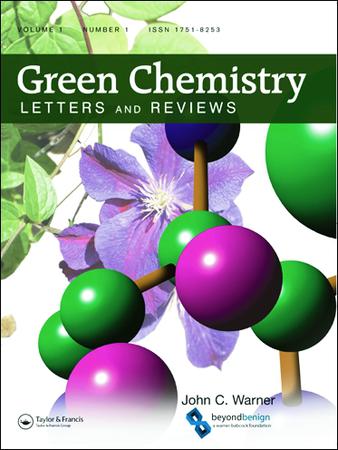Study the effect of simple extraction techniques to synthesizing promising antimicrobial bio-capped copper oxide nanoparticles
IF 5.1
3区 化学
Q1 CHEMISTRY, MULTIDISCIPLINARY
引用次数: 0
Abstract
Six samples of bio-capped copper oxide nanoparticles were made from two bio-waste extracts: Punica granatum L. peels and Psidium guajava Linn. leaves. Extraction methods included soaking in water or hydroethanol and boiling in water. The samples were characterized using FT-IR, XRD, SEM, and TGA. Results showed organic residue capping on CuO nanoparticles varied based on the extract and capping medium used. The thermal stability of all CuO samples was observed to be high, as recorded from TGA patterns and confirmed by EDX analysis, which showed a high content of copper ranging from 10.1 to 36.1%. TEM analysis revealed an average particle size of less than 20 nm for all six samples, suggesting a similarity in size. The soaking technique produced the most stable bio-capped CuO nanoparticles with a high negative zeta potential value. According to the study, the CuO samples synthesized from aqueous extracts obtained through soaking showed the highest antibacterial activity. This could be attributed to the high oxygen ratio, which was confirmed via EDX analysis. The bio-capped CuO was effective against multidrug- resistant gram-positive bacteria MRSA, and C. albicans. A mechanism was proposed to explain how the capping media affected the antimicrobial activity of the bio-capped CuO nanoparticles.研究了简单提取技术对合成具有抗菌前景的生物包覆氧化铜纳米颗粒的影响
以石榴皮和番石榴皮两种生物废弃物提取物为原料,制备了6个生物包覆氧化铜纳米颗粒样品。叶子。提取方法包括水浸泡或氢乙醇浸泡和水煮沸。采用FT-IR、XRD、SEM和TGA对样品进行了表征。结果表明,CuO纳米颗粒上的有机残留物封盖随提取液和封盖介质的不同而不同。通过热重分析和EDX分析,所有CuO样品的热稳定性都很高,铜含量在10.1 ~ 36.1%之间。TEM分析显示,所有六个样品的平均粒径小于20 nm,表明尺寸相似。浸泡法制备了最稳定的生物包覆CuO纳米颗粒,具有较高的zeta负电位值。研究表明,通过浸渍得到的水提物合成的CuO样品抗菌活性最高。这可能归因于高氧比,通过EDX分析证实了这一点。生物包盖的CuO对多重耐药革兰氏阳性细菌MRSA和白色念珠菌均有较好的抗菌效果。提出了一种盖层介质影响生物包覆CuO纳米颗粒抗菌活性的机理。
本文章由计算机程序翻译,如有差异,请以英文原文为准。
求助全文
约1分钟内获得全文
求助全文
来源期刊

Green Chemistry Letters and Reviews
CHEMISTRY, MULTIDISCIPLINARY-GREEN & SUSTAINABLE SCIENCE & TECHNOLOGY
CiteScore
9.10
自引率
3.00%
发文量
48
期刊介绍:
Green Chemistry Letters and Reviews is an Open Access, peer-reviewed journal focused on rapid publication of innovative new syntheses and procedures that reduce or eliminate the use and generation of hazardous materials. Reviews of state-of-the-art green chemistry technologies are also included within the journal''s scope.
Green Chemistry Letters and Reviews is divided into three overlapping topic areas: research, education, and industrial implementation. The journal publishes both letters, which concisely communicate the most time-sensitive results, and reviews, which aid researchers in understanding the state of science on important green chemistry topics. Submissions are encouraged which apply the 12 principles of green chemistry to:
-Green Chemistry Education-
Synthetic Reaction Pathways-
Research and Process Analytical Techniques-
Separation and Purification Technologies-
Renewable Feedstocks-
Degradable Products
 求助内容:
求助内容: 应助结果提醒方式:
应助结果提醒方式:


